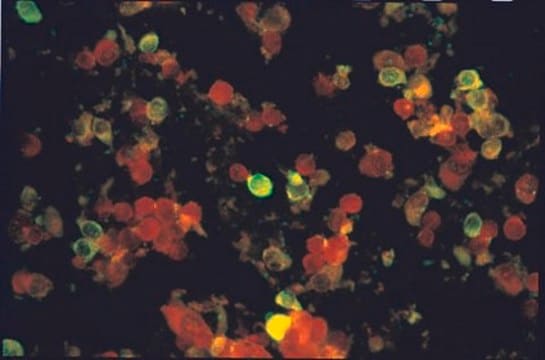AMP3100
Amplifluor® ID Pan-Enterovirus Kit
Iniciar sesiónpara Ver la Fijación de precios por contrato y de la organización
About This Item
UNSPSC Code:
12161503
eCl@ss:
32161000
NACRES:
NA.55
Productos recomendados
manufacturer/tradename
Amplifluor®
Chemicon®
Quality Level
technique(s)
DNA amplification: suitable
application(s)
genomic analysis
General description
Test Principle:
The Amplifluor® ID-Pan-Enterovirus Reagent is designed to evaluate amplified nucleic acid specific to the 5′ UTR of multiple prevalent enteroviral strains. Amplification reactions are performed using a reverse transcription (RT) primer for 1st strand cDNA synthesis, followed by Polymerase Chain Reaction (PCR) amplification utilizing the forward Amplifluor hairpin primer and reverse primer to produce enterovirus-specific fluorescent amplicons. The Amplifluor hairpin primer is labeled with Donor (fluorescein) and Quencher (DABSYL) fluorophores, which produce the high signal to noise ratio observed in the Amplifluor assay. Upon incorporation into new amplicons, the Amplifluor primer is fluorescent, while the fluorescein signal of the unincorporated Amplifluor primer (reported in the instrument′s FAM layer) is quenched (Diagram 1 on product insert ). When performed on a thermal cycler capable of real-time fluorescence detection, the amplification products of the PCR reaction can be monitored directly in a quantitative fashion, allowing evaluation of template detection in a single, closed-tube system with no associated assay procedure. Where required, template standard curves may be employed to quantitatively determine viral RNA load.
The Amplifluor® ID-Pan-Enterovirus Reagent is designed to evaluate amplified nucleic acid specific to the 5′ UTR of multiple prevalent enteroviral strains. Amplification reactions are performed using a reverse transcription (RT) primer for 1st strand cDNA synthesis, followed by Polymerase Chain Reaction (PCR) amplification utilizing the forward Amplifluor hairpin primer and reverse primer to produce enterovirus-specific fluorescent amplicons. The Amplifluor hairpin primer is labeled with Donor (fluorescein) and Quencher (DABSYL) fluorophores, which produce the high signal to noise ratio observed in the Amplifluor assay. Upon incorporation into new amplicons, the Amplifluor primer is fluorescent, while the fluorescein signal of the unincorporated Amplifluor primer (reported in the instrument′s FAM layer) is quenched (Diagram 1 on product insert ). When performed on a thermal cycler capable of real-time fluorescence detection, the amplification products of the PCR reaction can be monitored directly in a quantitative fashion, allowing evaluation of template detection in a single, closed-tube system with no associated assay procedure. Where required, template standard curves may be employed to quantitatively determine viral RNA load.
Application
The Amplifluor® ID Pan-Enterovirus Reagent is intended for the quantitative or qualitative evaluation of enterovirus RNA generated by a validated in vitro nucleic acid amplification of the 5′ untranslated region (UTR).
For Research Use Only
For Research Use Only
Components
25X Amplifluor® ID Pan-Enterovirua Forward Primer, 100 reactions, Light sensitive, Store at or below -20°C.
25X Amplifluor ID Pan-Enterovirus Reverse Primer, 100 reactions. Store at or below -20°C.
Positive Control for quantitation, 100 reactions. Store at or below -20°C.
25X Amplifluor ID Pan-Enterovirus Reverse Primer, 100 reactions. Store at or below -20°C.
Positive Control for quantitation, 100 reactions. Store at or below -20°C.
Storage and Stability
The Amplifluor® ID Pan-Enterovirus primers must be stored in the dark at -20ºC (or at -80ºC for long term storage). Amplifluor primers are light sensitive. Amplifluor primers may be divided into convenient aliquots and wrapped in foil to minimize light exposure.
Warnings and Precautions:
• Handle all specimens and materials coming in contact with them as potentially infectious materials. Decontaminate with 0.05% sodium hypochlorite (1:100 dilution of household bleach).
• Do not use reagents beyond expiration date.
• Nucleic acids are subject to degradation by nucleases found in the environment and on human surfaces. Clean and cover work surfaces with disposable coverings and wear powder free gloves during all procedures.
• Use pipetting techniques that will deliver correct volumes of reagents in all steps, including pre-wetting aerosol resistant pipette tips. Repeating pipettors should be primed and voided of all air bubbles.
• With nucleic acid amplification, the potential for carry-over contamination is high. Work in a unidirectional flow from workstation to workstation and always use dedicated equipment and aerosol-barrier pipette tips.
Warnings and Precautions:
• Handle all specimens and materials coming in contact with them as potentially infectious materials. Decontaminate with 0.05% sodium hypochlorite (1:100 dilution of household bleach).
• Do not use reagents beyond expiration date.
• Nucleic acids are subject to degradation by nucleases found in the environment and on human surfaces. Clean and cover work surfaces with disposable coverings and wear powder free gloves during all procedures.
• Use pipetting techniques that will deliver correct volumes of reagents in all steps, including pre-wetting aerosol resistant pipette tips. Repeating pipettors should be primed and voided of all air bubbles.
• With nucleic acid amplification, the potential for carry-over contamination is high. Work in a unidirectional flow from workstation to workstation and always use dedicated equipment and aerosol-barrier pipette tips.
Legal Information
Amplifluor is a registered trademark of Merck KGaA, Darmstadt, Germany
CHEMICON is a registered trademark of Merck KGaA, Darmstadt, Germany
Disclaimer
Unless otherwise stated in our catalog or other company documentation accompanying the product(s), our products are intended for research use only and are not to be used for any other purpose, which includes but is not limited to, unauthorized commercial uses, in vitro diagnostic uses, ex vivo or in vivo therapeutic uses or any type of consumption or application to humans or animals.
Storage Class
10 - Combustible liquids
Certificados de análisis (COA)
Busque Certificados de análisis (COA) introduciendo el número de lote del producto. Los números de lote se encuentran en la etiqueta del producto después de las palabras «Lot» o «Batch»
¿Ya tiene este producto?
Encuentre la documentación para los productos que ha comprado recientemente en la Biblioteca de documentos.
Nuestro equipo de científicos tiene experiencia en todas las áreas de investigación: Ciencias de la vida, Ciencia de los materiales, Síntesis química, Cromatografía, Analítica y muchas otras.
Póngase en contacto con el Servicio técnico








